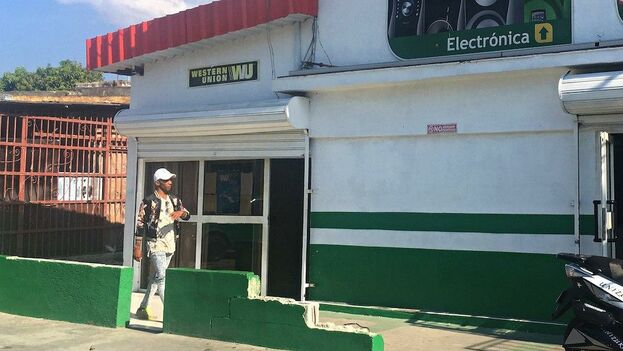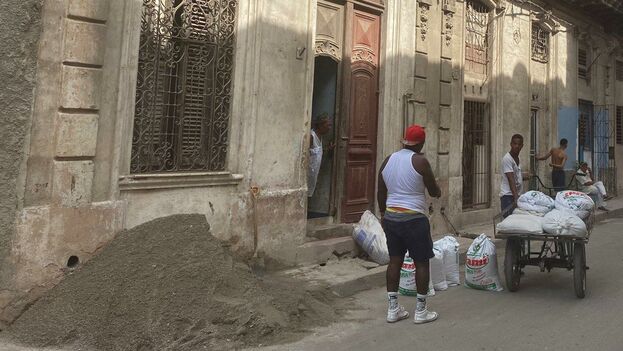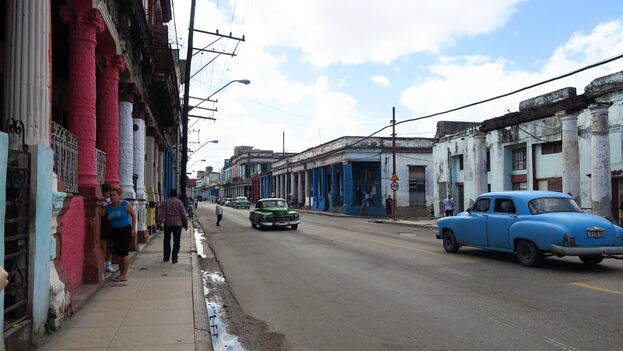
![]() 14ymedio, Marcelo Hernández, Havana, 5 February 2020 — You hear the sound of hammers and a wheelbarrow that comes loaded with mortar to finish building the bathroom. At the home of Olivia, age 28, there is an incessant movement of builders but the sound of the works can stop at any time.
14ymedio, Marcelo Hernández, Havana, 5 February 2020 — You hear the sound of hammers and a wheelbarrow that comes loaded with mortar to finish building the bathroom. At the home of Olivia, age 28, there is an incessant movement of builders but the sound of the works can stop at any time.
“I am waiting for the money that my sister will send me; if it does not arrive I have no way to pay the masons,” says this resident of Havana’s Cerro district. The “Western Union neighborhoods” live waiting for the remittances, prospering with dollars that arrive from the North and falling behind if they fail to arrive.
A few yards from where Olivia lives, on the corner of Ayestarán and Boyeros, is one of the more than 300 Western Union offices in Cuba. If remittances are the lifeblood that keeps hundreds of thousands of Cuban families alive, these places are the veins that distribute the liquid.
Olivia is lucky because her house is located just three blocks from that Western Union office, one that “almost never has a line,” she says. The issue of the line is vital, because in other more central offices, such as the one located in the Carlos III Plaza, people can wait hours to collect a remittance. “Between the time my sister calls me to tell me that she sent the dollars and and the time I collect the convertible pesos they give me, not an hour goes by,” says Olivia.
By a family agreement, the second floor of the house under construction will be for Olivia’s sister, so she sends an average of 200 dollars a month that guarantees her a place to stay if she visits Havana or returns to live on the Island. It has the clearest “Western Union” style: a bathroom with black tiles and a golden border, a large bathtub, a tiny balcony with a balustrade in the shape of small woman’s torsos and a cement lion at the entrance.
Unlike the architectural glamor of the areas built to the west of the city in the first half of the twentieth century, neighborhoods rebuilt through remittances often combine marginality and coquetry; streets deteriorated for decades and without paving, lined with facades of bright colors and floors that grow on narrow foundations like towers that stretch towards the sky. Some remain half-done for years, if the flow of dollars needed to finish them is cut off.

Although the US authorities recently imposed a limit of $ 1,000 per person per quarter for remittances to Cuba, most of those who live on that money on the Island do not need to exceed that amount. “When I started construction, they had to send me more money to buy the materials, but it’s very easy, one part was sent to me by my sister, another by my brother-in-law and the rest by the mother of my brother-in-law,” explains Olivia.
In the neighborhood where this young woman lives — who “neither studies nor works,” she says almost proudly — you can guess which are the homes that receive remittances. “This one across the street has two children in Miami and in the one on the corner with the newly painted balcony, only the grandparents remain in Cuba,” Olivia offers.
In this neighborhood there is no sound more precious than that of a telephone announcing the consignment. “Sometimes I’m like a crazy person waiting to be able to pay the electricity or to buy some food and then my mother calls me and my soul returns to my body,” says Samuel, 34, an engineer who became a bicycle repairman, who also resides in the vicinity of the remittance office.
“Since my children were born, their grandmother sends them the money it takes to maintain the supply of milk and food. They are the children of Western Union because without that I don’t know how we could raise them and ever since they were little they have gone with us to collect the money, so they recognize the office even with the light off,” he jokes. “Here, those yellow and black colors are the colors of economic relief.”

Walking along Calle Primelles, also en el Cerro, is like traveling a route along which the remittances flow from the nearby Western Union office. “This house used to be wonderful but the owners do not receive money and it’s falling over,” explains Damian, 41, as, like an ancient guide, he points out the details of the buildings on the busy road where he lives. “This room is barely a closet because only one person can live there but they’ve made it like a dollhouse with the money the owner sends,” he adds.
Faded facade: no remittances; a freshly varnished wooden door: a recipient of dollars. A fence full of rust: no family abroad; a bright blue plastic water tank on a rooftop: relatives in Miami. One could travel the whole street and identify, with a large percentage of success, who does and who does not frequently go to the office to collect a money transfer.
The giant Western Union is not only the global leader of money transfers and a very popular path in Latin America to receive remittances from migrants based in the United States, but, in the Cuban case, it is through these offices the the largest amount of the 3.5 billion dollars that annually cross the Florida Straits arrives, according to data offered by The Havana Consulting Group, based in Miami. However, it is impossible to assess the total money that arrives in Cuba in the form of remittances, because a large part comes in informally with travelers and ‘mules’ who frequently make the journey between Cuba and the United States.
The campaign known as the January break , arising from the exile, promoted a temporary cut in remittances, trips to the Island and telephone recharges during the first month of the year — as a way to put pressure on the regime to change. But the initiative does not seem to have yielded the expected results. “We have continued to have a good flow of remittances and this place has customers the entire time it is open to the public,” says the employee of a Western Union office in Old Havana.
The neighborhood where Olivia, Damián and Samuel live also clearly manifests that the flow of the lifeblood of remittances has not stopped, a nourishing liquid that flows from the nearby Western Union office: “Saint Western Union” as some call it with a mixture of humor and resignation.
______________
COLLABORATE WITH OUR WORK: The 14ymedio team is committed to practicing serious journalism that reflects Cuba’s reality in all its depth. Thank you for joining us on this long journey. We invite you to continue supporting us by becoming a member of 14ymedio now. Together we can continue transforming journalism in Cuba.
